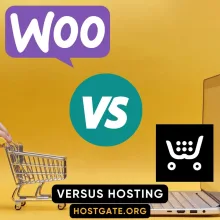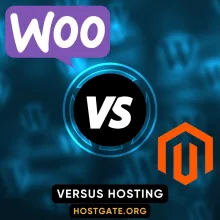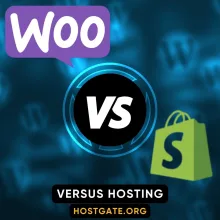WooCommerce vs BigCommerce – Which One is Better? | HostingVS
WooCommerce and BigCommerce represent two distinct approaches to ecommerce, each with unique strengths and limitations. WooCommerce, a WordPress plugin powering over 6.1 million websites, offers extensive customization options and flexibility but requires more technical management. BigCommerce, serving 41,900 stores, provides an all-in-one hosted solution with built-in features and easier management. The platforms differ significantly in their architecture, design capabilities, cost structure, and support systems.
WooCommerce excels in customization and cost control but demands more technical expertise and maintenance. BigCommerce offers streamlined operations and comprehensive built-in features but at higher monthly costs and with less flexibility. The choice between platforms ultimately depends on factors such as technical capabilities, budget constraints, customization needs, and scalability requirements. Both platforms can successfully power online stores, but their suitability varies based on individual business contexts and goals.

 Experience the Most Affordable and Reliable Cloud Web Hosting Cloud Web Hosting Starting at Just $3.99/month! - Unlimited Storage & Traffic - Free Domain Included - 24/7 Expert Support - Dedecated & VPS Hosting Plans |
WooCommerce vs BigCommerce | WooCommerce | BigCommerce |
Platform Architecture | - WordPress plugin requiring separate hosting | - All-in-one hosted solution |
Customization and Design | - 3,750+ themes available | - 205 themes available |
Technical Requirements | - Technical knowledge required | - Minimal technical knowledge needed |
Support and Documentation | - Community-based support | - 24/7 dedicated support |
Cost Structure | - Free base plugin | - All-inclusive monthly plans |
WooCommerce vs BigCommerce: A Comprehensive Platform Comparison
In the ever-evolving landscape of ecommerce platforms, WooCommerce and BigCommerce stand as two distinct solutions for online retailers. WooCommerce, launched in 2011 as a WordPress plugin, has grown to power over 6.1 million websites worldwide. BigCommerce, established in 2006 as a standalone hosted platform, serves approximately 41,900 stores. Despite their vastly different market shares, both platforms have attracted notable enterprises – BigCommerce powers sites for Sony and Toyota, while WooCommerce hosts the All Blacks rugby team and Singer sewing machines.
Platform Architecture and Core Functionality
The fundamental difference between these platforms lies in their architecture. BigCommerce operates as a fully hosted, all-in-one solution where users need only a web browser to manage their store. This approach provides automatic updates, security patches, and hosting management. WooCommerce, conversely, functions as a WordPress plugin with two deployment options: hosted WordPress.com or self-hosted WordPress.org installation. While this flexibility is advantageous, self-hosted WooCommerce users must handle hosting, security, and maintenance themselves – a potential drawback for less technically inclined merchants.
Design Capabilities and Customization Options
When it comes to design, both platforms offer distinctive approaches. WooCommerce boasts an impressive library of over 3,750 themes across various sources, with official themes priced between $47-$99 annually. BigCommerce provides 205 themes, with premium options available for a one-time fee of $99-$400. The customization experience differs significantly – BigCommerce employs a user-friendly drag-and-drop page builder, while WooCommerce utilizes WordPress’s block editor. A notable advantage for WooCommerce is its superior typography options and Google Fonts integration, though BigCommerce’s page builder might be more intuitive for beginners.
Technical Performance and Security
Performance characteristics reflect each platform’s architectural choices. BigCommerce’s hosted nature ensures optimized performance with guaranteed uptime and automatic scaling – a significant advantage for merchants who prefer a hands-off approach to technical management. WooCommerce’s performance varies greatly depending on hosting quality and optimization efforts. While both platforms offer robust security features, WooCommerce requires more active management of security measures and updates. This additional responsibility can be either an advantage or disadvantage, depending on the merchant’s technical expertise and desire for control.
Cost Structure and Total Ownership
Understanding the true cost of ownership reveals interesting contrasts. BigCommerce offers transparent, all-inclusive monthly plans, though initial costs may be higher. WooCommerce’s base plugin is free, but expenses accumulate through hosting, premium themes, essential plugins, and maintenance. A significant drawback for WooCommerce can be the unpredictable cost of plugins and extensions needed for advanced functionality. However, WooCommerce offers more control over individual expenses, allowing merchants to optimize costs based on their specific needs.
International Commerce and Scalability
Both platforms support international commerce but differ in implementation. BigCommerce includes built-in multi-currency support and international payment gateways, offering a more streamlined solution for global commerce. WooCommerce typically requires additional plugins for similar functionality, which can increase complexity and costs. However, WooCommerce’s WordPress foundation provides more flexible language options and customization possibilities for specific markets. The choice between platforms often depends on the merchant’s international commerce requirements and technical resources.
Marketing and SEO Capabilities
Marketing and SEO features demonstrate each platform’s approach to business growth. BigCommerce provides comprehensive built-in features including abandonment cart recovery, social media integration, and SEO optimization. While WooCommerce relies more heavily on plugins for marketing tools, it benefits from deep WordPress SEO integration through popular plugins like Yoast. A potential downside for WooCommerce is the need to manage and maintain multiple plugins for marketing functionality, while BigCommerce offers these features out-of-the-box.
Support Systems and Documentation
Support structures differ significantly between platforms. BigCommerce provides dedicated 24/7 support and comprehensive documentation – a crucial advantage for merchants requiring immediate assistance. WooCommerce primarily relies on community support through WordPress forums and third-party developers. While this can mean access to diverse perspectives and solutions, it might also result in longer resolution times for critical issues. Both platforms maintain active developer communities, but BigCommerce’s centralized support structure offers more consistent assistance.
Platform-Specific Advantages and Limitations
Each platform exhibits distinct strengths and limitations. BigCommerce excels as an all-in-one solution with strong built-in features and enterprise-grade capabilities, making it ideal for merchants seeking a comprehensive, managed solution. WooCommerce’s integration with WordPress offers unparalleled customization options and access to the world’s largest CMS ecosystem. However, this flexibility comes with increased complexity and maintenance requirements. The choice between platforms often depends on whether a merchant values customization flexibility over ease of management.
Conclusion: Making the Right Choice
The decision between WooCommerce and BigCommerce ultimately depends on specific business requirements and resources. WooCommerce proves ideal for businesses with technical expertise seeking maximum customization and control, particularly those already familiar with WordPress. Its main drawbacks include increased maintenance responsibility and potentially complex plugin management. BigCommerce, with its all-inclusive approach, better serves merchants prioritizing ease of use and requiring minimal technical overhead.
However, this convenience comes with less flexibility and potentially higher monthly costs. When making the final decision, merchants should carefully consider their technical capabilities, budget constraints, customization needs, and long-term scalability requirements. Both platforms are capable of powering successful online stores, but their suitability varies significantly based on individual business contexts and goals.
Summary and FAQs
Which platform is more cost-effective: WooCommerce or BigCommerce?
I’ll break down the cost-effectiveness of both platforms:
WooCommerce:
- Base platform is free but has hidden/accumulating costs:
- Hosting fees (varies by provider)
- Premium themes ($47-$99 annually)
- Essential plugins and extensions (unpredictable costs)
- Maintenance costs (time or money for technical support)
- Security management costs
BigCommerce:
- All-inclusive monthly plans that include:
- Hosting
- Security
- Updates
- Core features
- 24/7 support
- Premium themes (one-time fee of $99-$400)
The cost-effectiveness really depends on your specific needs:
WooCommerce is likely more cost-effective if:
- You have technical expertise to handle maintenance
- You need minimal additional features
- You’re already using WordPress
- You want to optimize costs by only paying for features you need
BigCommerce is likely more cost-effective if:
- You need an all-in-one solution
- You lack technical expertise
- You value predictable monthly costs
- You need enterprise-level features out of the box
- You want to minimize time spent on technical maintenance
There’s no universal answer – the cost-effectiveness depends on your business context, technical resources, and specific requirements. WooCommerce offers more control over individual expenses but requires more active management, while BigCommerce might have higher initial costs but includes more features and support by default.
Do I need technical knowledge to use WooCommerce or BigCommerce?
Here’s how the technical requirements differ between the platforms:
BigCommerce:
- Requires minimal technical knowledge
- Operates as a fully hosted, all-in-one solution
- Only needs a web browser to manage the store
- Includes automatic updates and security patches
- Features a user-friendly drag-and-drop page builder
- Manages hosting and maintenance for you
WooCommerce:
- Requires more technical expertise, especially if self-hosted
- Users must handle:
- Hosting management
- Security measures
- Regular maintenance
- Plugin updates
- WordPress integration
- Performance optimization
- Site backups
The key difference is that BigCommerce is designed for users who want a more hands-off technical approach, while WooCommerce offers more control but requires either:
- Technical knowledge to manage the platform yourself, or
- Resources to hire someone to handle the technical aspects
For beginners or those without technical expertise, BigCommerce would be the easier choice to start with. However, if you’re already familiar with WordPress or have access to technical support, WooCommerce’s learning curve wouldn’t be as challenging.
Which platform offers better customization options?
Here’s how the customization options compare between the platforms:
WooCommerce offers more extensive customization:
- Over 3,750 themes available across various sources
- Deep WordPress integration provides access to the entire WordPress ecosystem
- Superior typography options and Google Fonts integration
- Uses WordPress’s block editor for content customization
- Maximum flexibility due to open-source nature
- More control over site structure and functionality
- Unlimited potential for custom development
BigCommerce has more streamlined customization:
- 205 available themes
- Premium themes cost $99-$400 as a one-time fee
- User-friendly drag-and-drop page builder
- More intuitive for beginners
- Built-in features reduce need for custom solutions
- More structured approach to customization
- Limited by platform constraints
The key distinction is that WooCommerce offers greater customization potential but requires more technical knowledge to fully utilize it, while BigCommerce provides fewer options but makes customization more accessible through its user-friendly tools.
The better choice depends on your needs:
Choose BigCommerce if you prefer straightforward, user-friendly customization tools and don’t need extensive modifications
Choose WooCommerce if you want unlimited customization potential and have the technical expertise to implement it
Can both platforms handle international sales effectively?
Here’s how both platforms handle international commerce:
BigCommerce’s International Features:
- Built-in multi-currency support
- Integrated international payment gateways
- More streamlined solution for global commerce
- Ready to use out of the box for international sales
WooCommerce’s International Capabilities:
- Requires additional plugins for multi-currency support
- Needs extra extensions for international payment gateways
- More flexible language options through WordPress
- Better customization possibilities for specific markets
- Higher complexity due to plugin requirements
- Potentially higher costs for international features
Both platforms can handle international sales, but they approach it differently:
- BigCommerce provides a more straightforward, integrated solution that works immediately
- WooCommerce offers more flexibility but requires more setup and additional costs
The choice depends on your specific needs:
- Choose BigCommerce if you want a ready-to-use international solution with minimal setup
- Choose WooCommerce if you need highly specific customization for particular markets and don’t mind managing multiple plugins
Both can effectively handle international sales, but BigCommerce makes it easier out of the box while WooCommerce requires more setup but offers more customization options for specific market needs.
Which platform is better for scaling my business?
Here’s how both platforms handle scaling:
BigCommerce’s Scaling Advantages:
- Built for enterprise-level operations (powers sites like Sony and Toyota)
- Automatic scaling of hosting resources
- Guaranteed uptime
- Built-in features that support growth:
- Integrated marketing tools
- Automated cart recovery
- Multi-currency support
- Enterprise-grade security
- No need to worry about technical infrastructure as you grow
WooCommerce’s Scaling Capabilities:
- Powers millions of websites (including major brands like Singer)
- Flexible scaling options through:
- Choice of hosting providers
- Customizable infrastructure
- Extensive plugin ecosystem
- However, scaling requires:
- More active management
- Technical expertise
- Careful resource planning
- Additional investments in hosting and plugins
The better choice for scaling depends on your business model:
Choose BigCommerce if:
- You want predictable scaling costs
- You prefer a hands-off technical approach
- You need guaranteed enterprise-level performance
- You want built-in features ready for growth
Choose WooCommerce if:
- You need highly specific customizations as you grow
- You have technical resources to manage scaling
- You want complete control over your scaling strategy
- You’re already invested in the WordPress ecosystem
There’s no universal “better” platform for scaling – it depends on your business needs, technical resources, and preferred approach to growth.




